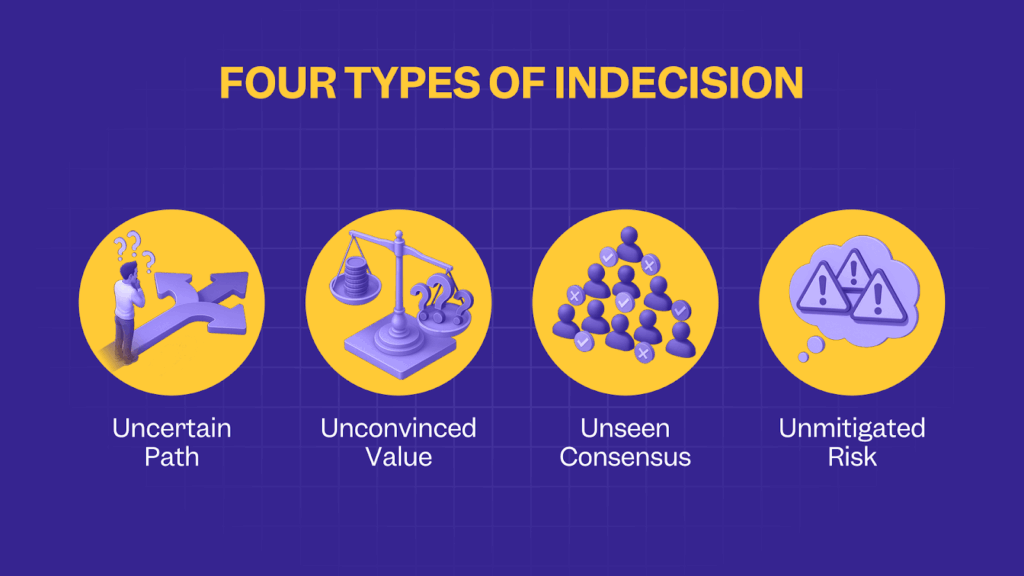
You’ve done everything right. The champion loves you, the business case is airtight, and you’ve beaten the competitor on every feature. Yet, the deal sits stagnant. The calendar ticks past the forecasted close date, and your emails are met with radio silence or vague replies. The problem isn’t a competitor. It’s not the price. The problem is often a silent, more insidious foe: buyer indecision.
In complex B2B sales, the cost of deciding internal politics, implementation hassle, fear of being wrong can outweigh the perceived cost of the problem. Your job is no longer just to sell your solution. It’s to make the act of deciding feel safe, obvious, and urgent.
Why Perfect Deals Still Stagnate

Buyer Indecision is a psychological state, not a logistical one. In the buyer’s mind, the status quo, however painful, is a known entity. Your solution, however brilliant, is unknown.
Common triggers include:
- The Paradox of Choice: Too many options overwhelm and freeze the buyer.
- Fear of Internal Conflict: Political battles inside the organization feel riskier than the solution itself.
- The Perfection Trap: Waiting for the “perfect” solution or complete data.
- Loss Aversion: Potential loss feels worse than potential gain.
Recognizing these triggers is the first step. Diagnosing them in your specific deals is the next.
Diagnosing the Four Types of Indecision

Not all indecision is the same. To solve it, you must diagnose its cause.
- The “Uncertain Path” Indecision: The buyer doesn’t know how to buy. They lack a clear internal process for evaluation and approval.
- Telltale Sign: “We’re still figuring out our process” or “We need to loop in [another department] but aren’t sure when.”
- Solution: Become a process consultant.
- Actionable Tactic: Draft a simple 30-60-90 day hypothetical project plan with clear owners for each phase. This makes the abstract concrete.
- Telltale Sign: “We’re still figuring out our process” or “We need to loop in [another department] but aren’t sure when.”
- The “Unconvinced Value” Indecision: The buyer isn’t fully sold that the pain of change outweighs the status quo.
- Telltale Sign: “We need to think about the ROI more” or “It’s just not the right time budget-wise.”
- Solution: Quantify the cost of inaction.
- Actionable Tactic: Calculate the impact of delaying change. For example: “If your team spends 10 hours a week on manual reporting, that’s $X per quarter lost. Each month delayed costs another $Y.”
- Telltale Sign: “We need to think about the ROI more” or “It’s just not the right time budget-wise.”
- The “Unseen Consensus” Indecision: Your champion is on board, but other stakeholders are silent skeptics.
- Telltale Sign: “We’re still building internal consensus” or radio silence after a positive meeting.
- Solution: Map the human terrain using Agent Pi.
- Why Agent Pi fits: It profiles the stakeholders you know to predict concerns of those you don’t. Example: If your champion is highly Amiable, they might avoid conflict with a Driver-style skeptic. This insight allows you to arm your champion with data-driven arguments to win over the skeptical stakeholders.
- Telltale Sign: “We’re still building internal consensus” or radio silence after a positive meeting.
- The “Unmitigated Risk” Indecision: The buyer is paralyzed by “what-ifs” implementation failure, unmet expectations, or personal repercussions.
- Telltale Sign: Over-focus on security, implementation, or contract clauses long before the decision is made.
- Solution: Offer safety nets to reduce perceived risk.
- Actionable Tactic (clarified): Provide examples that reduce uncertainty. Show case studies from their industry, outline a phased implementation plan, and set clear, simple success criteria for the first 90 days. Let them know the plan includes an “off-ramp” if things don’t go perfectly.
- Telltale Sign: Over-focus on security, implementation, or contract clauses long before the decision is made.
The Strategic Pivot: Questions That Uncover Real Objections

Stop asking generic status questions. Instead, diagnose the type of indecision:
- Instead of: “Are we still on track to sign?”
- Try: “As you look at the final steps, which part of the internal process feels most unclear or challenging?” (Uncertain Path)
- Try: “As you look at the final steps, which part of the internal process feels most unclear or challenging?” (Uncertain Path)
- Instead of: “Do you have any other concerns?”
- Try: “When you present this to the final approver, what’s the single most important piece of data they’ll need to feel comfortable?” (Unconvinced Value or Unseen Consensus)
- Try: “When you present this to the final approver, what’s the single most important piece of data they’ll need to feel comfortable?” (Unconvinced Value or Unseen Consensus)
- Instead of: “What can I do to help?”
- Try: “Imagine we implement this and it’s a wild success in six months. What had to happen for that to be true, and what could get in the way?” (Unmitigated Risk)
Building an Indecision-Proof Sales Process
Empower your team with the right insights at the right time.
- For Strategists: Use Agent Miia to identify companies undergoing significant change, new leadership, shifts in financials, or market pressure. These organizations are more receptive to change because the pain of the status quo is acute, reducing indecision.
- For Frontline Reps: Use Agent Pi to understand the risk tolerance and communication style of each buyer. Analytical personalities need data to feel safe. Drivers need control over outcomes. Tailor your approach to each buyer to unlock decisiveness.
From Stalled to Closed
Buyer Indecision is the final frontier in complex sales. However, simply labeling a deal as “indecisive” is as useless as marking it “no budget”; it’s a symptom, not a diagnosis. By moving beyond the generic label to pinpoint the specific cause Uncertain Path, Unconvinced Value, Unseen Consensus, or Unmitigated Risk you can apply the right strategy to get deals moving again.
By recognizing its forms, diagnosing root causes, and applying empathetic, risk-mitigating strategies, you transform from a vendor being evaluated into a guide leading buyers to a confident decision.
The goal: Make your solution not just the best choice, but the easiest and safest decision they can make.
